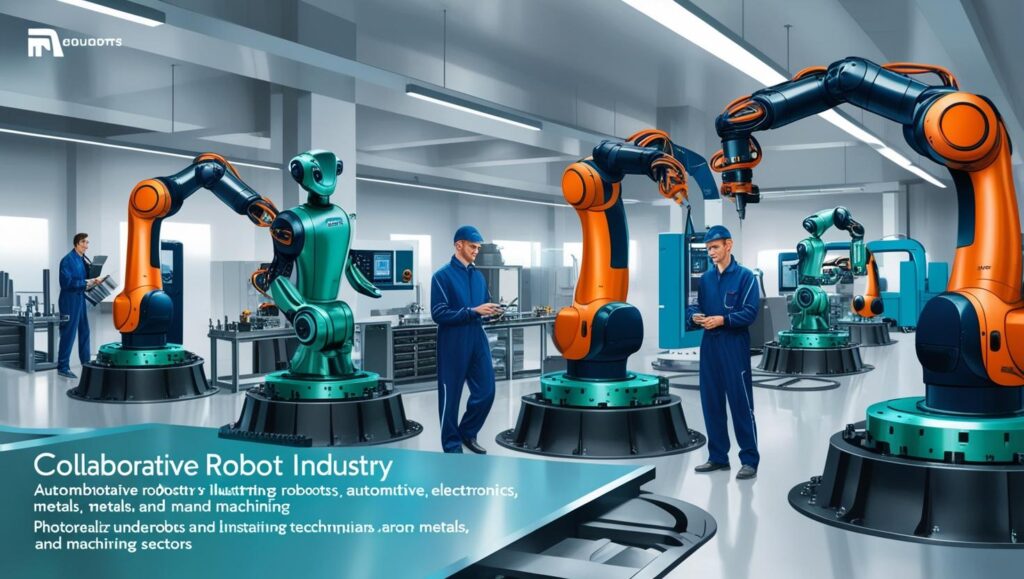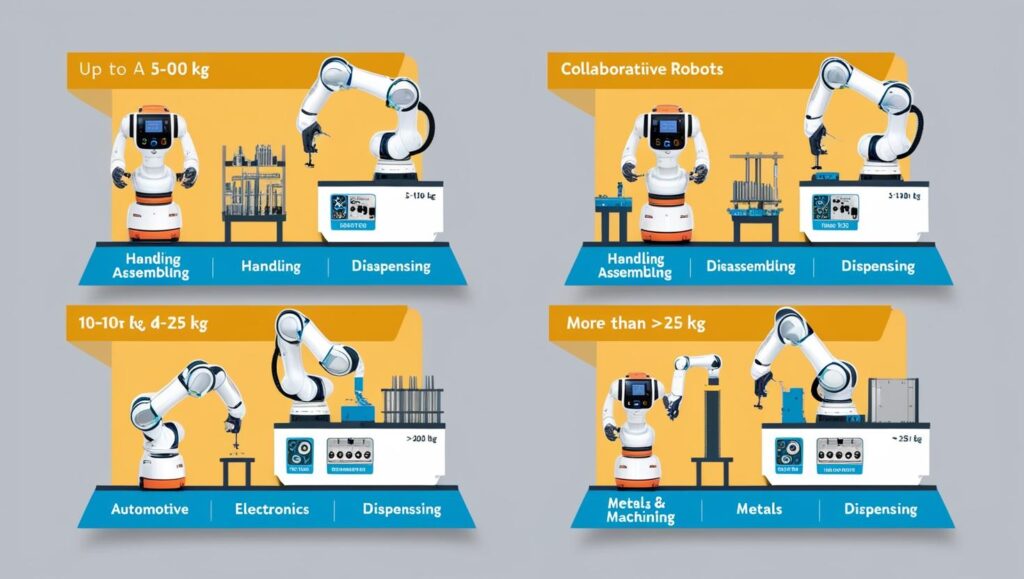The global collaborative robot (cobot) market is witnessing significant growth as industries across the spectrum increasingly turn to automation to enhance productivity, flexibility, and safety. Among the leading adopters, the automotive, electronics, and metals & machining sectors are at the forefront of deploying collaborative robots to transform manufacturing operations.

Surge in Automation Demand Drives Cobot Growth
Collaborative robots, designed to work safely alongside humans, have emerged as a practical automation solution for a wide range of industrial tasks. Unlike traditional industrial robots, cobots are compact, cost-effective, and adaptable, making them particularly attractive to small and mid-sized enterprises (SMEs) and high-mix, low-volume production environments.
The global cobot market is projected to grow at a compound annual growth rate (CAGR) of over 35.2% through 2030, driven by demand for agile automation solutions, labor shortages, and the ongoing digital transformation of manufacturing.
Automotive Industry: A Pioneer in Cobot Adoption
The automotive industry has long been a leader in industrial automation, and cobots are the latest tool in its arsenal. Automotive manufacturers are using collaborative robots for tasks such as assembly, welding, painting, and parts handling, allowing for greater flexibility on the production line and improved human-machine collaboration.
Major automakers and Tier 1 suppliers are leveraging cobots to enable more customized vehicle production, reduce downtime, and streamline repetitive processes while improving worker safety.
Electronics Sector: Precision and Scalability
In the electronics industry, cobots are being used for high-precision tasks such as PCB handling, soldering, screw driving, and testing. As electronic devices become smaller and more complex, the demand for fine, repetitive work that requires consistent quality is increasing. Cobots help meet these demands with speed and accuracy, often working alongside human technicians on intricate assembly lines.
Given the fast-paced nature of electronics production, cobots offer the scalability manufacturers need to respond to fluctuating consumer demand while maintaining product integrity.
Metals & Machining: Improving Efficiency and Safety
The metals and machining industry, traditionally labor-intensive and physically demanding, is undergoing a transformation through cobot integration. Collaborative robots are being deployed for machine tending, welding, polishing, and quality inspection, helping to reduce worker fatigue, enhance precision, and maintain consistent output across long production runs.
In environments where safety and efficiency are critical, cobots play a key role by performing hazardous or ergonomically challenging tasks, thereby minimizing risk to human workers.
Collaborative Robot industry growth
The Collaborative Robot industry size is projected to grow from USD 1.9 billion in 2024 and is estimated to reach USD 11.8 billion by 2030; it is expected to grow at a Compound Annual Growth Rate (CAGR) of 35.2% from 2024 to 2030.
Download PDF Brochure @ https://www.marketsandmarkets.com/pdfdownloadNew.asp?id=194541294

Key Opportunities in the Collaborative Robot Market
Adoption by Small and Medium Enterprises (SMEs)
One of the most significant opportunities in the collaborative robot market lies in its ability to empower small and medium-sized manufacturers. Traditional industrial robots are often too expensive, complex, and space-intensive for SMEs. In contrast, cobots are relatively low-cost, easy to deploy, and require minimal floor space and safety infrastructure. This accessibility enables smaller companies to automate tasks they previously handled manually, leading to improvements in productivity, product quality, and operational efficiency. As cobots become more user-friendly and affordable, SME adoption is expected to accelerate significantly across all regions.
Automating Repetitive and Physically Demanding Tasks
Cobots are well-suited for tasks that are repetitive, monotonous, or physically taxing for human workers. In industries like automotive and machining, workers often face fatigue and injury from repetitive strain or lifting heavy parts. Cobots can take over these tasks—such as machine tending, pick-and-place, or screwdriving—freeing up human workers for higher-value activities. This not only improves production efficiency but also enhances worker safety and job satisfaction. By addressing labor fatigue and turnover, cobots help manufacturers maintain consistent output and quality.
Integration with Smart Technologies (AI, Vision, IoT)
Another powerful opportunity lies in the integration of cobots with smart technologies such as artificial intelligence, machine vision, and the Industrial Internet of Things (IIoT). These enhancements allow cobots to make real-time decisions, adapt to changes in the environment, and conduct more complex tasks such as quality inspection or part identification. Vision-guided cobots can detect product defects, perform precision alignments, and manage varying part geometries—tasks that were once too difficult for standard automation. This trend aligns with the broader push toward Industry 4.0 and smart manufacturing.
Flexibility for High-Mix, Low-Volume Production
Cobots offer a unique advantage in high-mix, low-volume manufacturing environments—common in electronics, custom automotive parts, and job shops. Unlike traditional robots that require complex programming and retooling for each product variant, cobots are easily reprogrammed and can be trained by demonstration. This makes them ideal for facilities that handle frequent changeovers or customized production. Manufacturers using cobots can scale production up or down quickly and efficiently, leading to faster time-to-market and improved responsiveness to customer demands.
Addressing Skilled Labor Shortages
Across the globe, manufacturers are facing a shortage of skilled labor, particularly in trades such as welding, machining, and electronics assembly. This labor gap presents a significant opportunity for cobots to fill in where human expertise is unavailable or in short supply. Collaborative robots can be deployed to perform essential functions under the supervision of fewer human operators, enabling companies to maintain or even increase production levels despite labor constraints. This is especially valuable in regions where aging workforces and declining vocational enrollment threaten future production capacity.
Expansion into Non-Traditional Applications
While cobots initially gained traction in assembly and material handling, they are now being adopted for a growing range of applications such as packaging, palletizing, polishing, deburring, and product testing. This diversification allows companies to extract more value from a single cobot investment by using it across multiple workstations or departments. For instance, a cobot that handles loading parts during the day can be repurposed for packaging or inspection tasks during off-hours. This multi-functionality significantly increases the ROI and versatility of cobot deployments.
Enabling Safer Work Environments and Human-Robot Collaboration
Cobots are designed with safety in mind, incorporating features such as force-limiting sensors, emergency stop buttons, and smooth edges to minimize injury risks. They comply with international safety standards like ISO/TS 15066, allowing them to operate in close proximity to human workers without safety cages. This opens up opportunities for true human-robot collaboration, where workers and machines can share tasks and workspaces harmoniously. The result is not only improved safety but also more flexible factory layouts and a reduction in capital costs associated with protective infrastructure.
The Future of Collaborative Robotics
As collaborative robots become smarter, more user-friendly, and capable of handling a wider range of applications, their adoption across industries is expected to accelerate. Integration with artificial intelligence (AI), machine vision, and cloud-based analytics will further enhance their functionality, allowing for real-time optimization and predictive maintenance.
Government initiatives to support advanced manufacturing, coupled with increased awareness of workplace safety and productivity gains, are likely to drive continued investment in cobot technology.
About MarketsandMarkets™
MarketsandMarkets™ is a blue ocean alternative in growth consulting and program management, leveraging a man-machine offering to drive supernormal growth for progressive organizations in the B2B space. We have the widest lens on emerging technologies, making us proficient in co-creating supernormal growth for clients.
The B2B economy is witnessing the emergence of $25 trillion of new revenue streams that are substituting existing revenue streams in this decade alone. We work with clients on growth programs, helping them monetize this $25 trillion opportunity through our service lines – TAM Expansion, Go-to-Market (GTM) Strategy to Execution, Market Share Gain, Account Enablement, and Thought Leadership Marketing.
Built on the ’GIVE Growth’ principle, we work with several Forbes Global 2000 B2B companies – helping them stay relevant in a disruptive ecosystem. Our insights and strategies are molded by our industry experts, cutting-edge AI-powered Market Intelligence Cloud, and years of research. The KnowledgeStore™ (our Market Intelligence Cloud) integrates our research, facilitates an analysis of interconnections through a set of applications, helping clients look at the entire ecosystem and understand the revenue shifts happening in their industry.
To find out more, visit www.MarketsandMarkets™.com or follow us on Twitter, LinkedIn and Facebook.
Contact:
Mr. Rohan Salgarkar
MarketsandMarkets™ INC.
630 Dundee Road
Suite 430
Northbrook, IL 60062
USA : 1-888-600-6441